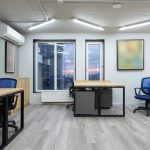Colors in your office can greatly affect your mood and productivity. Light colors create an open, airy vibe that boosts energy and creativity, while dark colors may contribute to feelings of sadness and anxiety. Balancing light and dark tones can enhance your work environment, combining the uplifting qualities of light shades with the depth of darker hues. If you want to explore how different color schemes can transform your workspace, keep going for more insights.
Table of Contents
Key Takeaways
- Light colors enhance mood by creating an open atmosphere that boosts energy and creativity among employees.
- Dark colors can induce feelings of sadness, anxiety, and reduced motivation, negatively impacting productivity.
- A balance of light and dark tones can promote focus while adding depth and sophistication to the office environment.
- Light shades improve employee well-being by reflecting natural light, reducing stress, and improving overall focus.
- Successful office designs often incorporate bright colors to stimulate creativity, while dark accents can provide visual interest and motivation.
The Psychology of Color in the Workplace
When you step into an office, the colors surrounding you can greatly influence your mood and productivity. Bright colors, like yellow and green, often evoke feelings of energy and creativity, making you feel more alert.
On the other hand, dark colors, such as navy or charcoal, might create a sense of seriousness or even confinement, affecting your motivation. You might find that lighter shades allow for a more open and inviting atmosphere, while darker hues can lead to feelings of heaviness.
Understanding these psychological effects can help you choose the right colors for your workspace. By intentionally selecting colors that resonate with your goals, you can create an environment that enhances your well-being and encourages peak performance.
Benefits of Light Colors in Office Design
Light colors in office design can greatly enhance the overall atmosphere and productivity of a workspace. They create a sense of openness and airiness, making your environment feel more inviting and less cramped.
When you incorporate light colors, like soft whites, pastels, or light grays, you’ll notice a boost in energy and creativity among employees. These hues can also improve focus and reduce stress, allowing you to tackle tasks with greater ease.
Additionally, light colors reflect natural light, brightening up your office and reducing the need for artificial lighting. This not only saves energy but also promotes a healthier work environment.
The Impact of Dark Colors on Employee Well-being
While dark colors can create a sense of sophistication and elegance in an office, they can also negatively impact employee well-being. When surrounded by darker hues, you might experience:
- Increased feelings of sadness or depression
- Heightened anxiety levels
- Reduced motivation and productivity
- Strain on creativity and innovation
- A sense of isolation or disconnection from others
These effects can be subtle but significant, affecting your overall mood and performance.
If your workplace leans heavily towards dark colors, consider incorporating some lighter accents or elements to balance the environment. You’ll likely find that a mix of hues can help enhance your well-being and create a more inviting atmosphere for everyone.
After all, a positive mood can lead to greater workplace satisfaction and success.
Balancing Light and Dark Tones for Optimal Productivity
To create an environment that boosts productivity, it’s essential to find the right balance between light and dark tones in your office space.
Light colors can promote energy and focus, while dark tones often add depth and sophistication. Consider using a base of light colors for walls and larger furniture, as they make the space feel open and inviting.
Light colors energize and enhance focus, while dark tones add sophistication and depth to your workspace.
You can then incorporate dark accents through office supplies, artwork, or furniture pieces. This combination not only enhances visual interest but also helps you stay motivated.
Aim for a ratio that feels comfortable—too much of either can lead to feelings of overwhelm or boredom.
Case Studies: Successful Color Schemes in Modern Offices
Many modern offices have successfully embraced innovative color schemes that enhance both aesthetics and productivity.
If you’re looking to revamp your workspace, consider these case studies showcasing effective color choices:
- Google: Bright primary colors stimulate creativity and collaboration.
- Airbnb: Soft pastels create a calming atmosphere, promoting focus.
- Zappos: Bold, vibrant hues encourage energy and engagement among employees.
- WeWork: Neutral tones paired with pops of color foster a professional yet inviting environment.
- Trello: A mix of greens and blues enhances clarity and reduces stress.
Frequently Asked Questions
How Do Cultural Differences Influence Color Preferences in the Workplace?
Cultural differences shape your color preferences profoundly. In some cultures, bright colors symbolize joy and creativity, while in others, muted tones convey professionalism. Understanding these nuances can enhance your workplace environment and improve team dynamics.
Can Color Preferences Vary by Age Group in Office Settings?
Absolutely, color preferences can vary by age group in office settings. Younger employees might prefer vibrant colors that energize, while older workers could lean towards more muted tones, reflecting their experiences and expectations in professional environments.
What Role Does Personal Style Play in Office Color Choices?
Your personal style greatly influences your color choices in the office. It reflects your personality and can enhance your confidence, helping you create an environment that feels comfortable and aligns with your individual aesthetic preferences.
How Does Natural Light Affect the Perception of Office Colors?
Natural light enhances colors in your office, making them appear more vibrant and inviting. When you incorporate natural light, you’ll notice how it transforms the overall atmosphere, boosting your mood and productivity throughout the day.
Are There Specific Color Trends Emerging in Modern Office Design?
You’ll notice specific color trends emerging in modern office design, like calming greens and vibrant blues. These colors foster creativity and collaboration, while neutrals provide a sleek backdrop that enhances focus and productivity.




